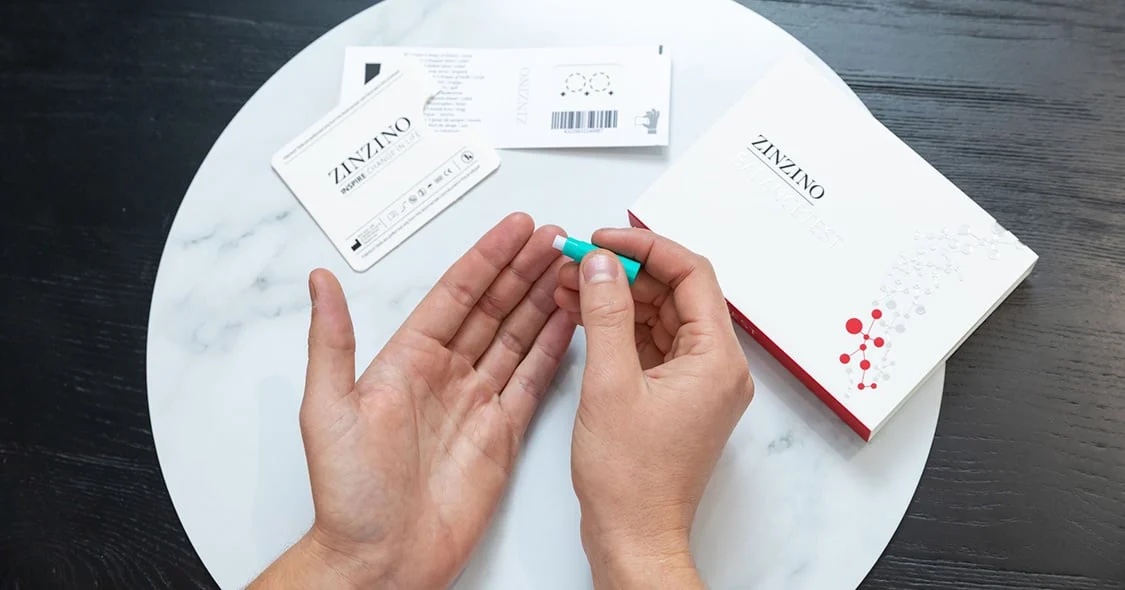BalanceTest
Code: 6106Product detailed description
Main benefits
- Easy-to-perform self-test using a dried blood spot
- Measures the amount of 11 fatty acids in your blood
- Provides data on your omega-6:3 balance
What we measure
The test measures the amount of 11 fatty acids, including saturated, monounsaturated (omega-9) and polyunsaturated (omega-6 and omega-3) fatty acids. The values of the individual fatty acids are shown in a table and expressed as percentages of the total measured amount of fatty acids. For comparison, the table shows the average range for each fatty acid as a target value (based on data obtained from a large group of people with a known balance). Measurements are taken for the following fatty acids:
Palmitic acid, C16:0, saturated fats
Stearic acid, C18:0, saturated fats
Oleic acid, C18:1, omega-9
Linoleic acid, C18:2, omega-6
Alpha-linolenic acid, C18:3, omega-3
Gamma-linolenic acid, C18:3, omega-6
Dihomo-gamma-linolenic acid, C20:3, omega-6
Arachidonic acid (AA), C20:4, omega-6
Eicosapentaenoic acid (EPA), C20:5, omega-3
Docosapentaenoic acid (DPA), C22:5, omega-3
Docosahexaenoic acid (DHA), C22:6, omega-3

Certified test kit
Zinzino has had this dried blood spot test certified for compliance with European Directive 98/79/EC on in vitro diagnostic medical devices (IVD). This means that the test and all its components comply with legal regulations, therefore the kit bears the CE marking.
This is how your results are calculated
The amounts of 11 fatty acids are analysed, and their total sum is considered to be 100%. We use 7 of the fatty acids to calculate the following 6 values. For the analysed quantity of each
of these 7 fatty acids, a percentage is calculated
of the total 100%.
1. Omega-3 eicosapentaenoic acid (EPA)
2. Omega-3 docosahexaenoic acid (DHA)
3. Omega-3 docosapentaenoic acid (DPA)
4. Omega-6 arachidonic acid (AA)
5. Omega-6 Dihomo-gamma-linolenic acid (DGLA)
6. Saturated fats, palmitic acid (PA)
7. Saturated fats, stearic acid (SA)
Protection Value
First, the following 3 recognised health indicators are calculated:
1. The value for the omega-6 ratio is calculated as follows: (DGLA+AA) * 100 / (DGLA+AA+EPA+DPA+DHA)
2. The value for the omega-3 level is the sum of EPA+DHA
3. The balance value can be calculated as omega-6 (AA) / omega-3 (EPA)
Each indicator's value is given the same weight in the second calculation and is assigned a value between 0 and 100, which is then divided by 3, resulting in a Protective Value, ideally exceeding 90. This result only indicates the protective level of the fatty acid, not the person's health status.
Please note! EPA and DHA values have a significant impact on all calculations, and if the percentage shares of EPA and DHA are low, the result is usually very low or even zero Protective Values
Omega-3 Index
The Omega-3 Index is the sum of the percentage values for the two 'marine' omega-3 fatty acids, EPA and DHA. The ideal combined level is at least 8%, but higher levels are desirable
values, for example 10%.
Omega-3 fatty acids are beneficial in many ways as they are the basic building blocks of your cells. EPA is predominant in the blood, muscles, and tissues, while DHA is predominant in the brain, sperm, and eyes.
Omega-6:3 balance
This balance can be calculated by dividing the percentage value of AA by the percentage value of EPA (AA/EPA), which is then expressed as a Balance Value, for example, 3:1. The omega-6:3 balance in the body should be less than 3:1.
If this ratio is higher than 3:1, you will benefit from a change in diet. A low omega-6 to omega-3 ratio is important for maintaining normal cell and tissue development (homeostasis) and helps the body suppress inflammation.
Cell Membrane Fluidity
Fluidity can be calculated by dividing the percentage value of two saturated fats by the percentage value of two omega-3 acids. The fluidity value is therefore defined as (PA+SA) / (EPA+DHA), and the result is expressed as a fluidity index, for example, 3:1. If the fluidity value is less than 4:1, it means that the fluidity of the cell membranes is sufficient. The more saturated fats there are in the membrane, the stiffer the membrane is. Conversely, the more polyunsaturated fats there are in the membrane, the more fluid the membrane is. The composition of the cell membrane and structural architecture are crucial for cell health, and therefore body health. On the one hand, the membrane must be firm enough to ensure a healthy cellular structural architecture. On the other hand, the membrane must be sufficiently fluid and permeable to allow the supply of nutrients and the removal of waste products.
Mental Strength
It is calculated as the ratio of the percentage value of AA to the sum of the percentage values of EPA and DHA, i.e. the Mental Strength value = AA / (EPA+DHA). The result is expressed as a mental strength value, for example 1:1. If we want to achieve a sufficient and even supply of omega-6 and omega-3 fatty acids to the brain and nervous system, this value should be less than 1:1.
Cognitive performance increases in proportion to the increase in consumption of “marine” omega-3 acids EPA and DHA. Childhood and old age are two critical and sensitive stages, and a lack of omega-3 is associated with poorer learning and memory, as well as mental health problems.
Arachidonic Acid Index (aa)
The AA Index shows the measured value of the omega-6 fatty acid arachidonic acid (AA) as a percentage of the total measured fatty acids. The correct average values are in the range of 6.5 to 9.5%, with an optimal target value of 8.3%.
Arachidonic acid (AA) is the most important omega-6 fatty acid for the human body. Omega-6 acids trigger the production of local hormones (such as prostaglandins, thromboxanes and leukotrienes) in body tissues, and this acid is the starting point for the production of these hormones, whose functions vary. However, their main common function is to protect the human body from damage by limiting the spread of infection or the consequences of injury.

Performing the test
1. The Zinzino Test is an approved in vitro diagnostic product for personal home blood sampling.
- First, wash your hands with soap, rinse thoroughly with warm water and dry.
2. Remove the sample card from the paper envelope. Keep the envelope for later use. Detach the part of the sample card marked KEEP and photograph the test identification number. You can only see your test results if you have the anonymous test identification number. Place the card on the table with the side with two circles facing up.
3. Stimulate blood flow by circling your entire arm or shaking your hands downwards for 20 seconds.
4. Remove the single-use lancet. Remove the transparent safety cap and the lancet is ready for use. Clean the tip of your finger (middle finger recommended) with an alcohol swab. Place the lancet against the lower part of the fingertip, facing the collection sheet on the table. Press the top of the lancet towards your finger until you hear a click. The lancet will automatically make a small prick in your finger.
5. Do not touch the filter paper with your fingers.
6. Gradually drip blood into each circle until they are filled. Gently squeeze your finger and wait for a drop of blood to drip into the circle. If one drop of blood does not fill the circle, immediately drip another drop from your finger into it. Leave the sample card in a horizontal position at room temperature for at least 10 minutes to allow the samples to dry thoroughly.
7. Place the sample card back into the paper envelope. Then place the paper envelope into the metallic bag and seal everything. IMPORTANT: Do not remove the desiccant bag from the metallic pouch.
8. Place the sealed metallic bag into the large envelope with the laboratory address. NOTE! Before placing the envelope in the mailbox, you must affix the correct number of postage stamps to the envelope. Register your test code at www.zinzinotest.com. You will also be able to view your test results on this website later. Your results will be available in 10–20 days.
IMPORTANT: Keep the part of the card marked KEEP. You can only see your test results if you have the anonymous test identification number.
Be the first who will post an article to this item!
.svg)